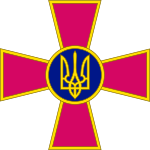
A | B | C | D | E | F | G | H | CH | I | J | K | L | M | N | O | P | Q | R | S | T | U | V | W | X | Y | Z | 0 | 1 | 2 | 3 | 4 | 5 | 6 | 7 | 8 | 9
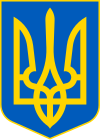 |
|---|
|
|
The Armed Forces of Ukraine[b] (abbreviated as AFU)[c] are the military forces of Ukraine. All military and security forces, including the Armed Forces, are under the command of the President of Ukraine and subject to oversight by a permanent Verkhovna Rada parliamentary commission. They trace their lineage to 1917, while the modern armed forces were formed after Ukrainian independence in 1991. As of 2024, it is the sixth largest and one of the best-funded armed forces in the world.[9] The Ukrainian Armed Forces also operates one of the largest and most diverse drone fleet in the world.[10] The Ukrainian Armed Forces is one of the most battle-hardened armed forces in the world.[11]
Ukraine's armed forces are composed of the Ground Forces, the Air Force, the Navy, the Air Assault Forces, the Marine Corps, the Special Operations Forces, and the Territorial Defense Forces.[12] Ukraine's navy includes its own Naval Aviation. The Sea Guard is the coast guard service of Ukraine, and it is organized as part of the Border Guard Service, not subordinate to the navy. The National Guard serves as a paramilitary reserve component of the Armed Forces.
Military units of other countries have participated regularly in multinational military exercises in Ukraine.[13] Many of these exercises have been held under the NATO cooperation program Partnership for Peace. As of 2024, with over $400 billion in foreign military aid in addition to being one of the best-funded armed forces in the world, the Soviet era military equipments of the Armed Forces of Ukraine are fast being replaced with vast amounts of NATO standard military equipments.[14]
History
The formation of the national armed forces in the modern sense dates back to the beginning of the twentieth century and coincides with the formation of the modern Ukrainian nation. In official history, this period is referred to as the "Ukrainian War of Independence" or the "First Liberation Struggle." This process coincided with the end of the First World War and the subsequent collapse of great European empires from previous centuries. The forerunner event was the creation of national military formations in the Imperial and Royal Armies of Austria-Hungary, namely the Legion of Ukrainian Sich Riflemen, on which Ukrainian paramilitary organizations in Galicia were based: Sich Sports and Fire Brigade, "Sokil" and the national scout organization "Plast".[citation needed][15]
After the upheavals of World War I and on the verge of the collapse of empires, the Ukrainians tried again to return to sovereign statehood. As part of the growing disintegration in the ranks of the Russian Imperial Army, national units began to form. After the Bolshevik coup, hybrid warfare broke with the Russian Soviet Federative Socialist Republic and the White Guard. During the undeclared war, the Army of the Ukrainian People's Republic had already formed, but its formation was interrupted by the German administration. It continued in a limited form after the establishment of Hetman of Ukraine Pavlo Skoropadskyi's Ukrainian State, known as the Hetmanate. The national armed forces continued to develop. The Armed Forces of the Ukrainian state were planned in a more systematic way than in previous versions, although previous development was used in this process, and many mistakes were also made.[16]
Uprisings against the Hetmanate's rule eventually resulted, and the reorientation of the Central Powers who lost in World War I against the Entente, which in turn supported the White Guard movement and the Russian Empire as its original ally.[citation needed]
Simultaneously with these events, after the fall of the Russian Empire in 1917, numerous military formations were formed on Ukrainian lands, including detachments of the Free Cossacks, Father Makhno's Ukrainian Insurgent Army,[17] and the Bolshevik Red Cossacks. The latter became the basis of the puppet armed forces of the UkrSSR, and after the occupation of the Ukrainian People's Republic were included in the Red Army. After the collapse of the Austro-Hungarian Empire in 1918, the Ukrainian Galician Army came to the defense of the Western Ukrainian People's Republic, based on the formation of the Ukrainian Sich Riflemen of the former Austro-Hungarian Army.[18]
During World War II, Ukrainians tried to regain independence and organized armed units and formations, including the Ukrainian Insurgent Army,[19] but all of them were destroyed by Soviet authorities[20] within a few years after the war, and Ukrainians were again forced to serve in the Soviet Armed Forces.[citation needed][21]
Origins of the post-1992 Ukrainian Armed Forces
By 1992, the Ukrainian Armed Forces had been completely inherited from the Soviet Union, in which Ukraine had been a member state (a union republic). Like other Soviet republics, it did not possess its own separate military command, as all military formations were uniformly subordinated to the central command of the Soviet Armed Forces. Administratively, the Ukrainian SSR was divided into three Soviet military districts (the Carpathian Military District, Kyiv Military District, and Odesa Military District). Three Soviet air commands and most of the Black Sea Fleet naval bases were located on the coast of Ukraine. Majority of the officers were educated in Soviet educational institutions, many of them which came under the AFU, what is now the Ivan Bohun High School was actually a Soviet-established institution.
When the Soviet Union collapsed in 1991, the newly independent state of Ukraine inherited one of the most powerful force groupings in Europe. According to an associate of the Conflict Studies Research Centre, James Sherr: "This grouping, its inventory of equipment and its officer corps was designed for one purpose: to wage combined arms, coalition, offensive (and nuclear) warfare against NATO on an external front".[22] At that time, the former Soviet armed forces in the Ukrainian SSR included the 43rd Rocket Army, the 5th, 14th 17th and 24th Air Armies of the Soviet Air Forces, an air-defense army (8th Air Defence Army), three regular armies, two tank armies, the 32nd Army Corps, and the Black Sea Fleet.[23] Altogether the Armed Forces of Ukraine included about 780,000 personnel, 6,500 battle tanks, [citation needed], about 7,000 armored vehicles, 1,500 combat aircraft, and more than 350 ships of the former Soviet Navy. Along with their equipment and personnel, Ukraine's armed forces inherited the battle honors and lineage of the Soviet military forces stationed in Ukraine, as well as Guards unit titles for many formations. However, due to the deterioration of Russian-Ukrainian relations and the continued stigma of being associated with the Soviet Union, in 2015 President Poroshenko ordered the removal of most of the citations awarded during the Soviet era to formations of the Armed Forces and other uniformed organizations.[24]
In February 1991, a parliamentary Standing Commission for Questions of Security and Defense was established. On 24 August 1991, the Ukrainian parliament (the Verkhovna Rada), in adopting the Declaration of Independence of Ukraine, also enacted a short resolution "About military formations in Ukraine".[25] This took jurisdiction over all formations of the armed forces of the Soviet Union stationed on Ukrainian soil and established one of the key agencies, the Ukrainian Ministry of Defense.[26] On 3 September 1991, the Ministry of Defence commenced its duties. On 22 October 1991 units and formations of the Soviet Armed Forces on Ukrainian soil were nationalized.[27] Subsequently, the Supreme Council of Ukraine adopted two Laws of Ukraine on 6 December 1991 regarding the creation of the Armed Forces (this is marked as Armed Forces Day),[28][29] and Presidential Decree #4 "About Armed Forces of Ukraine" on 12 December 1991.[30] The government of Ukraine surrendered any rights of succession to the Soviet Strategic Deterrence Forces[31] (see Strategic Missile Troops) that were staged on the territory of Ukraine. Recognizing the complications of a smooth transition and seeking a consensus with other former members of the Soviet Union in dividing up their Soviet military inheritance, Ukraine joined ongoing talks that started in December 1991[32] regarding a joint military command of the Commonwealth of Independent States.[33]
Inherent in the process of creating a domestic military were political decisions by the Ukrainian leadership regarding the country's non-nuclear and international status. Among these were the definition, agreement, and ratification of the 1990 Treaty on Conventional Armed Forces in Europe (CFE), which not only established the maximum level of armament for each republic of the former USSR, but also a special ceiling for the so-called CFE "Flank Region" – included in this region were Ukraine's Mykolaiv, Kherson and Zaporizhzhia oblasts, and the Autonomous Republic of Crimea. Another key event in the development of the Ukrainian military was the 1992 Tashkent Treaty, which laid out aspirations for a Commonwealth of Independent States military. However, this collective military proved impossible to develop because the former republics of the USSR all wished to go their own way, ripping the intricate Soviet military machine into pieces.
Ukraine had observer status with the Non-Aligned Movement of nation-states from 1996.[34] However, due to the 2014 Russian aggression against Ukraine, the Verkhovna Rada repealed this status in December 2014.[35]
Arms control and disarmament

Following the breakup of the Soviet Union, Ukraine inherited two divisions of the Strategic Rocket Forces' 43rd Rocket Army (HQ Vinnytsia):
- the 19th Rocket Division (Khmelnytskyi) (90 UR-100N/SS-19/RS-18) and *the 46th Rocket Division at Pervomaisk, Mykolaiv Oblast, equipped with 40 SS-19 and 46 silo-mounted RT-23 Molodets/SS-24s.[36] While Ukraine had physical control of these systems, it did not have operational control. The use of the weapons depended on Russian-controlled electronic Permissive Action Links and the Russian command and control system.[37][38]

Ukraine voluntarily gave up these and all other nuclear weapons during the early 1990s. This was the first time in history that a country voluntarily gave up the use of strategic nuclear weapons, although South Africa was dismantling its small tactical nuclear weapons program at about the same time.
Ukraine had plentiful amounts of highly enriched uranium, which the United States wanted to buy from the Kharkiv Institute of Physics and Technology. Ukraine also had two uranium mining and processing factories, a heavy water plant and technology for determining the isotopic composition of fissionable materials. Ukraine possessed deposits of uranium that were among the world's richest. In May 1992, Ukraine signed the Strategic Arms Reduction Treaty (START I), in which the country agreed to give up all nuclear weapons and to join the Nuclear Non-Proliferation Treaty as a non-nuclear weapon state. Ukraine ratified the treaty in 1994, and as of 1 January 1996, no military nuclear equipment or materials remained on Ukrainian territory nor even were operated by the AFU.
On 13 May 1994, the United States and Ukraine signed a Memorandum of Understanding on the Transfer of Missile Equipment and Technology. This agreement committed Ukraine to the Missile Technology Control Regime F(MTCR) by controlling exports of missile-related equipment and technology according to the MTCR Guidelines.
Ukraine and NATO estimate that 2.5 million tons of conventional ammunition were left in Ukraine as the Soviet military withdrew, as well as more than 7 million rifles, pistols, mortars, and machine guns. The surplus weapons and ammunition were stored in over 180 military bases, including in bunkers, salt mines and in the open.[39] As of 2014, much of this surplus had not been scrapped.[40][41]
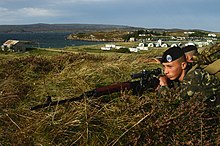
Attempt at reforms and constant fund shortages
Ukraine's first military reforms began in December 1996, with the adoption of a new "State Program for the Building and Development of the Armed Forces of Ukraine". One aspect of it was to shrink the standard combat unit from division size to brigade size, which would then fall under the command of one of the three newly created military districts:
- the Western Operational Command,
- the Southern Operational Command, and the largest
- the Northern Operational/Territorial Command.[42] Only Ukraine's 1st Airmobile Division was not downsized. This downsizing occurred purely for financial reasons, with the Ukrainian economy in recession this was a way to shrink the government (defense) expenditure and at the same time to release hundreds of thousands of young people into the private sector to stimulate growth.[43] During this time Ukraine's military-industrial complex also began to develop new indigenous weapons for the armed forces like the T-84 tank, the BMP-1U, the BTR-3, KrAZ-6322, and the Antonov An-70. All these reforms were championed by Leonid Kuchma, the second President of Ukraine, who wanted to retain a capable military and a functioning military-industrial complex on the basis of a mistrust for Russia, stating once "The threat of Russification is a real concern for us".[44]
The cancellation of the modernization program left a question of how to provide jobs in the military industrial complex which then comprised a double-digit percentage of the GDP. Export of new and modernized weapons on the world's arms markets was settled on as the best option, where Ukraine both tried to undercut the contracts of the Russian arms industry – offering the same service for a cheaper price, and was willing to sell equipment to whoever was willing to pay (more than once to politically unstable or even aggressive regimes), causing negative reactions from both Western Europe and the United States federal government.[45] During this time 320 T-80 tanks were sold to Pakistan and an unfinished Soviet aircraft carrier the Varyag, today known as the Chinese aircraft carrier Liaoning.[46]
Though the military was well-equipped, it still experienced lack of funds particularly for training and exercises, which led to a number of incidents. In one. the Siberia Airlines Flight 1812 of 2001 and the Sknyliv airshow disaster of 2002, but the military's effectiveness was demonstrated in the Tuzla Island Conflict.[citation needed]
| Armed Forces of Ukraine |
|---|
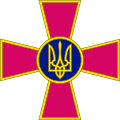 |
| Main branches |
| Law enforcement |
| Related services |
| Intelligence |
| History of the Ukrainian Military |

Ukrainian military tactics and organization heavily depended on Cold War tactics and former Soviet Armed Forces organization.[citation needed] Under former President Yushchenko, Ukraine pursued a policy of independence from Russian dominance, and thus tried to fully integrate with the West, specifically NATO.

Until the Euromaidan crisis of 2014, Ukraine retained tight military relations with Russia, inherited from their common Soviet history. Common uses for naval bases in the Crimea and joint air defense efforts were the most intense cooperative efforts. This cooperation was a permanent irritant in bilateral relations, but Ukraine appeared economically dependent on Moscow, and thus unable to break such ties quickly. After the election of President Viktor Yanukovych, ties between Moscow and Kyiv warmed, and those between Kyiv and NATO cooled, relative to the Yushchenko years.
Russo-Ukrainian War (2014 – present)

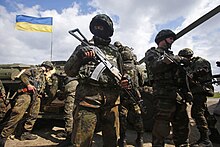
In March 2014, following the Revolution of Dignity and the annexation of Crimea by the Russian Federation, the government of Ukraine announced a new military service, the National Guard of Ukraine. Previously, a National Guard had existed up to 2000, so the 2014 NG was a reformation of the one raised in 1991, but this time formed part of the Internal Troops of Ukraine.
In May 2014, when Russian aggression started in the eastern regions, a helicopter with 14 soldiers on board, including General Serhiy Kulchytskiy, who headed combat and special training for the country's National Guard, was brought down by militants near Sloviansk in East Ukraine. Outgoing President Oleksandr Turchynov described the downing as a "terrorist attack," and blamed pro-Russian militants.[47]
In the early months of the Russo-Ukrainian War, the Armed Forces were widely criticised for their poor equipment and inept leadership, forcing Internal Affairs Ministry forces like the National Guard and the territorial defence battalions to take on the brunt of the fighting in the first months of the war.[48][49]
In late July 2015, the Ukrainian Defense Ministry revealed the new Ukrainian Armed Forces uniform designs, and later a revised rank insignia system was created.[50] These made their national debut on 24 August 2016, at the National Independence Day Silver Jubilee parade in Independence Square, Kyiv.
From the early 1990s, the Armed Forces had numerous units and formations with Soviet Armed Forces decorations dating back to the Second World War or earlier. Due to the decommunization process in Ukraine, all these decorations were removed from unit titles and regimental colours by 15 November 2015 to cease promotion and glorification of the Soviet symbols.[51][24] Ukraine had retained a number of Guards units, also following a Soviet tradition. A list can be seen at List of guards units of Ukraine. On 22 August 2016, the "Guards" titles were removed from all unit and formation names.[52] Only one brigade, the 51st, a former Guards unit, had been dissolved the year before.
By February 2018, the Ukrainian armed forces were larger and better equipped than ever before, numbering 200,000 active-service military personnel and most of the volunteer soldiers of the territorial defence battalions had been integrated into the official Ukrainian army.[53]
In late 2017-early 2018 the United Nations Human Rights Monitoring Mission in Ukraine reported that human rights abuses allegedly committed by Ukrainian security forces and armed groups remained an ongoing issue of the war in Donbas that erupted in 2014. The nature of the alleged crimes ranged from unlawful or arbitrary detention to torture, ill-treatment, and sexual violence. Within the reporting period of 16 November 2017 to 15 February 2018 the Office of the United Nations High Commissioner for Human Rights (OHCHR) monitoring mission documented 115 cases of credible allegations of human rights violations committed by both sides of the conflict since 2014.[54]
On 1 February 2022, the Territorial Defense Forces (TDF) were formed as the new branch of the Armed Forces. The TDF serves as a military reserve force which is formed by volunteers who are mobilized for local defense.[55] The branch is an expansion of the old territorial defence battalions system established in 2014.[55]
Ukraine and NATO membership

Ukraine's stated national policy is Euro-Atlantic integration, with the European Union. Ukraine has a "Distinctive Partnership" with NATO (see Enlargement of NATO) and has been an active participant in Partnership for Peace exercises and in peacekeeping in the Balkans. This close relationship with NATO has been most apparent in Ukrainian cooperation and combined peacekeeping operations with its neighbor Poland in Kosovo. Ukrainian servicemen also served under NATO command in Iraq, Afghanistan and in Operation Active Endeavour.[56][57]
Former President of Ukraine Viktor Yushchenko had asked for Ukrainian membership by early 2008.[58][59] During the 2008 Bucharest summit, NATO declared that Ukraine could become a member of NATO at Ukraine's discretion and when it met the criteria for accession.[60]
His successor, Viktor Yanukovych, considered the level of co-operation between Ukraine and NATO sufficient.[60]
Yanukovych, however, opted to keep Ukraine a non-aligned state. This was formalised on June 3, 2010, when the Verkhovna Rada excluded, with 226 votes, the goal of "integration into Euro-Atlantic security and NATO membership" from the country's national security strategy.[61] Amid the Euromaidan unrest, Yanukovych fled Ukraine in February 2014.[62]

The interim Yatsenyuk Government which came to power, initially said, with reference to the country's non-aligned status, that it had no plans to join NATO.[63]
However, following the Russo-Ukrainian War and parliamentary elections in October 2014, the new government made joining NATO a priority.[64] On 23 December 2014, the Verkhovna Rada renounced Ukraine's non-aligned status[62][65] that "proved to be ineffective in guaranteeing Ukraine's security and protecting the country from external aggression and pressure".[66]
The Ukrainian military is since transforming to NATO standards.[67] Prime Minister of Ukraine Arseniy Yatsenyuk stated early February 2016 that de facto the Armed Forces must, soon as possible, begin its transition for Ukrainian entry into NATO and towards NATO-capable armed forces.[67]
During the Russian buildup on the border in 2021, President Volodymyr Zelenskyy made a renewed call to Western powers for NATO membership, but was ultimately unsuccessful.[68]
However, following the 2022 Russian invasion of Ukraine, NATO military logistical support, including a wide array of arms and ammunition, was rapidly provided by NATO countries, and continued to the present (mid-2024) -- with commitments for its indefinite continuance—and NATO officials and member states' leaders began to declare that Ukraine's eventual membership in NATO was expected following conclusion of the war.[69][70][71][72]
In 2023, Ukraine's defense minister, Oleksii Reznikov, described Ukraine as, essentially, a "de facto" member of NATO, with the expectation that "in the near future" Ukraine would become an actual "de jure" member of NATO.[73]
Russian invasion of Ukraine
On Thursday, 24 February 2022, the Russian Armed Forces invaded Ukraine.[74] The Ukrainian Armed Forces and its auxiliary and wartime-affiliated organizations, have participated in many of the combat actions of the current conflict. Alongside the combat actions, the influx of Western weapons and materiel to the Armed Forces from NATO member armed forces, ex-Soviet stock from many Eastern European nations as well as captured Russian tanks, armed vehicles and other weapons[75] have also resulted in an ongoing modernization and expansion of the forces at large.

As of 2010[update] the total personnel was 200,000 (including 41,000 civilian workers).[76] Conscription was stopped in October 2013;[77] at that time the Ukrainian armed forces were made up of 40% conscripts and 60% contract soldiers.[77] Acting President Oleksandr Turchynov reinstated conscription in May 2014.[78]
In early 2014, Ukraine had 130,000 personnel in its armed forces, which could be boosted to about one million with reservists.[78][needs update]
There were a reported total of 250,800 personnel in the Armed Forces in 2015.[79] In July 2022, Defense Minister Oleksii Reznikov stated that the Armed Forces had an active strength of 700,000; Reznikov also mentioned that with the Border Guard, National Guard, and police added, the total comes to around one million.[80]
Following the Revolution of Dignity, Ukraine adopted a military doctrine focusing on defense against Russia and announced Ukraine's intentions for closer relations with NATO armed services, most especially if it joins the organization in the future.[81]
Structure
The law 'On the Foundations of National Resistance'[82] establishes the following structure of the Ukrainian Armed Forces:

- General Staff of the Armed Forces of Ukraine
- Joint Forces Command of the Armed Forces of Ukraine
- services of the UAF
- separate branches of the UAF
- Special Operations Forces Command
- Territorial Defense Command
- Logistical Forces Command
- Support Forces Command
- Medical Forces Command
- separate troop arms of the UAF
- Air Landing Assault Troops Command
- Signals and Cyber-Security Troops Command
- organs of military command and control, formations and units, which are separate from the services, branches and arms
Ministry of Defence
The following establishments and institutions fall directly under MoD subordination:[83]
Structures directly subordinated to the Ukrainian Ministry of Defence
Ukrainian Ministry of Defence Apparatus, Kyiv
- Main Intelligence Directorate
- Security Service of the MoD
- Main Inspection
- Defence Policies Directorate
- Defence Information Policies and Strategic Communications Directorate
- Military Education and Science Department
- Military Technical Policies, Development and Military Weaponry and Equipment Department
- Internal Audit department
- Military Policies and Strategic Planning Department
- State Purchases and Deliveries of Material Resources Department
- Information Organisation Works and Control Department
- Personnel Policies Department
- International Defence Co-operation Department
- Social and Personnel Policies Support Department
- Financial Department
- Judicial Support Department
- Military Representations Directorate
- Anti-Corruption Directorate
- State Secrets Security Directorate
- Press and Information Directorate
- Physical Culture and Sport Directorate
- Control Measures Coordination Unit
- Mobilization Preparedness Unit
- State Aviation Scientific Development Institute, Kyiv
- State Scientific Test Center of the AFU (MU А4444), Honcharivsk, Chernihiv Oblast
- Central Scientific Research Institute of the AFU (MU А0202), Kyiv
- Central Military Weaponry and Equipment Scientific Research Institute of the AFU (MU А4566), Kyiv
- Scientific Research Center of the Missile and Artillery Troops (MU А????), Sumy, Sumy Oblast
- Scientific Research Center for Humanitarian Matters of the AFU (MU А2350), Kyiv
- Central Directorate for Acquisition and Delivery of Material Supplies of the AFU, Kyiv
- Codification Bureau (MU А2387), Kyiv
- Military Delegations of the MoU
Chief of the General Staff
The Chief of the General Staff oversees the Armed Forces of Ukraine. The following units fall under the direct supervision of the General Staff:
Apparatus of the Commander of the Armed Forces of Ukraine, Kyiv
Office of the General Staff of the Armed Forces of Ukraine, Kyiv
Units directly subordinated to the General Staff of the AFU:
- Joint Forces Command (MU А0135), Kyiv
- Main Command Center of the AFU (MU А0911), Kyiv
- Back-up Command Center of the AFU (MU А3258), Radomyshl, Zhytomyr Oblast
- 15th Airborne Command and Control Center of the General Staff of the AFU (MU А0905), Vinnytsia, Vinnytsia Oblast
- Main Directorate for Moral and Psychological Support of the AFU, Kyiv
- Main Directorate for Military Cooperation and Verification of the AFU, Kyiv
- Central Military Security Directorate, Kyiv
- Directorate for Career Development of NCO Personnel, Kyiv
- 101st Separate Security Brigade of the General Staff 'Colonel-General Henadii Vorobiov' (МУ А0139), Kyiv
- other units and establishments directly under the General Staff of the AFU
Military Educational Establishments and Units (directly under the MoD)
- National Defense University of Ukraine 'Ivan Chernyakhovsky', Kyiv
- Military Institute of the Taras Shevchenko National University of Kyiv, Kyiv
- Zhytomyr Military Institute 'Sergei Korolev', Zhytomyr, Zhytomyr Oblast
- 190th Training Center, Huyva, Zhytomyr Oblast
- Military Judicial Institute of the Yaroslav Mudryi National Law University, Kharkiv, Kharkiv Oblast
- Kyiv Military High School 'Ivan Bohun', Kyiv
Ukrainian Ground Forces

This section needs to be updated. (July 2022) |
As of 2016, there were a reported 169,000 personnel in the Ukrainian Ground Forces.[84] The 2022 Russian invasion of Ukraine resulted in massive increases in personnel numbers; Defence Minister Reznikov stated the armed forces had a strength of 700,000 in July 2022, not counting the border guard, national guard, or police.[80] The Ukrainian Ground Forces are divided into Armoured Forces and Mechanized Forces, Army Aviation, Army Air Defence and Rocket and Artillery Troops. There are 13 mechanized brigades and two mountain warfare brigades in the Mechanized Forces. Ukraine also has two armoured brigades. There are also seven rocket and artillery brigades. Until 2013, the Ground Forces were divided into three army corps. These were disbanded in 2013 and reorganized as Operation Command West, Operation Command North and Operation Command South. Operation Command East was formed in 2015 to coordinate forces in the war in Donbas.
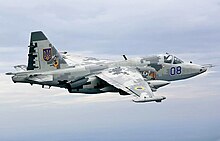
Ukrainian Air Force
This section needs to be updated. (July 2022) |
In 2016, the Ukrainian Air Force was reported to have included 36,300 personnel.[85][86]
The Air Force is organized into:[citation needed]
- Air Force General Command
- National Air Force University
- Western Command
- Central Command
- Eastern Command
- Southern Command
Its speciality formations are:
- Aviation units
- Fighter/Tactical Brigades
- Transport Brigades
- Helicopter Tactical Brigades
- Air Defense Missile Artillery
- Anti-Air Defense Regiments/Brigades Zdroj:https://en.wikipedia.org?pojem=Signal_Troops_Day
Text je dostupný za podmienok Creative Commons Attribution/Share-Alike License 3.0 Unported; prípadne za ďalších podmienok. Podrobnejšie informácie nájdete na stránke Podmienky použitia.
Antropológia
Aplikované vedy
Bibliometria
Dejiny vedy
Encyklopédie
Filozofia vedy
Forenzné vedy
Humanitné vedy
Knižničná veda
Kryogenika
Kryptológia
Kulturológia
Literárna veda
Medzidisciplinárne oblasti
Metódy kvantitatívnej analýzy
Metavedy
Metodika
Text je dostupný za podmienok Creative
Commons Attribution/Share-Alike License 3.0 Unported; prípadne za ďalších
podmienok.
Podrobnejšie informácie nájdete na stránke Podmienky
použitia.
www.astronomia.sk | www.biologia.sk | www.botanika.sk | www.dejiny.sk | www.economy.sk | www.elektrotechnika.sk | www.estetika.sk | www.farmakologia.sk | www.filozofia.sk | Fyzika | www.futurologia.sk | www.genetika.sk | www.chemia.sk | www.lingvistika.sk | www.politologia.sk | www.psychologia.sk | www.sexuologia.sk | www.sociologia.sk | www.veda.sk I www.zoologia.sk

